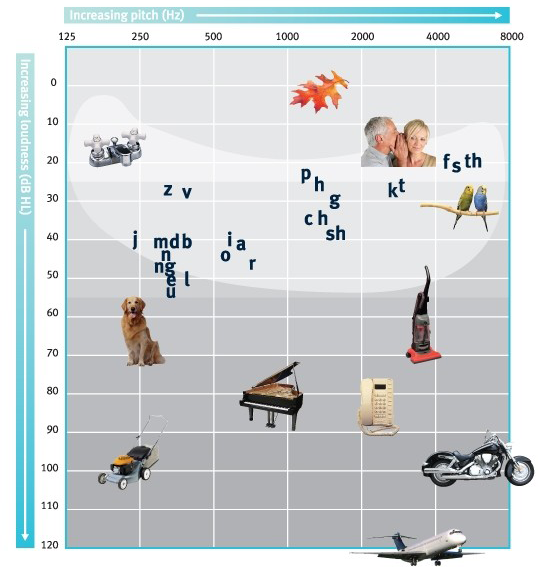You’ve been diagnosed with a certain degree of hearing loss, but you’re not really sure what that means.
Your degree, or severity, of hearing loss is determined by measuring your hearing threshold, which is the level of sound that is just barely heard in each ear. The louder the sound must be before you can hear it represents your degree of hearing loss. The results are placed on an audiogram, which documents hearing threshold at varying pitches. Loudness is measured in decibels hearing level (dB HL) on the vertical axis and pitch (or frequency) is measured in Hertz (Hz) and is represented on the horizontal axis of the audiogram. Results can vary by frequency and ear.
Degrees of hearing loss can be broken down into the following categories (see graph for visual):
Mild hearing loss– thresholds for various pitches between 25 to 40 dB HL (sounds such as a whisper or the chirping of birds). With mild hearing loss, it may be difficult to hear people speaking with soft voices, from a distance, or over background noise.
Moderate hearing loss – thresholds for various pitches between 41 to 55 dB HL (examples of sound may include light traffic or a distant train.) Moderate hearing loss makes conversations difficult, even without background noise.
Moderately severe hearing loss – thresholds for various pitches range between 56 to 70 dB HL (sounds in this range include a vacuum cleaner and a barking dog). Group discussions present the biggest challenge for those in this category.
Severe hearing loss – thresholds for various pitches between 71 to 90 dB HL (sounds within this range may include a piano playing and the ringing of a telephone.) Normal conversation is not possible, and there will difficulty in all situations. Speech may only be understood at close range or in a shouting tone.
Profound hearing loss – thresholds at 91 dB HL and above (lawn mowers, motor cycles, jet engines are all sounds above 91 dB). Even with amplification, those with profound hearing loss may not be able to understand speech.

*The shaded area represents the sound created from the human voice at a normal conversation level.
Our recommendations for treatment options will be based, in part, on your degree of hearing loss. Different makes and models of hearing aids are best suited for people with certain degrees of hearing loss as well.
Start your journey to better hearing at Audio Help Hearing Centers, conveniently located in the Manhattan and Scarsdale neighborhoods. Schedule your free hearing screening with us today!

